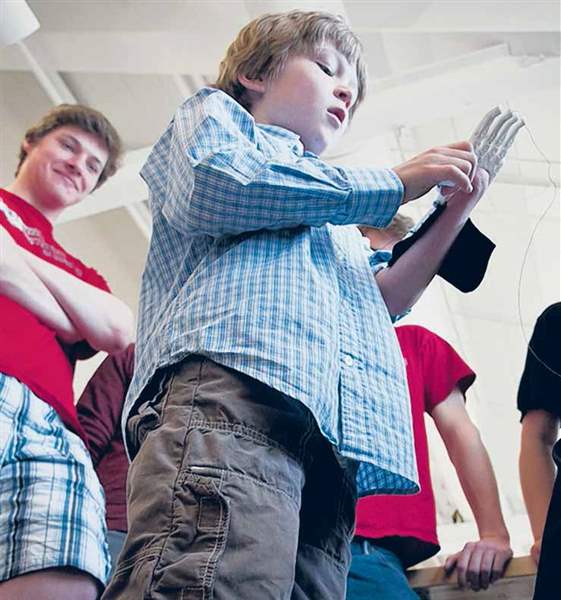
Students create robotic hand for boy, 8
5/5/2014
Steele Songle tries on the artificial hand.
PHILADELPHIA INQUIRER

Eight-year-old Steele Songle smiles at his mother, Ellen, after trying on an artificial hand designed by high school engineering students.
WEST CHESTER, Pa. — Steele Songle was born without a left hand but has never let that hold him back from the thing he loves most — playing sports.
And now, the 8-year-old from Wilmington, Delaware, who plays lacrosse and golf, swims, skis, and bounces on his friend’s trampoline until the two of them collapse, is getting a bit of bionic help from engineering students at the Westtown School in Chester County, Pennsylvania.
As part of their design and engineering class, using a 3-D device, the students are making a robotic hand with fingers that can open and close around a lacrosse stick or ski pole.
Among other things, Steele says he is confident the hand will improve his trampoline-basketball game.
“I can grip better on the trampoline and slam-dunk better,” said Steele, a sandy-haired charmer who maneuvered and played with the device as if it were the coolest toy on the planet, during a visit to the 600-acre campus.
“That would be fabulous,” said his mother, Ellen, associate director of parent and alumni engagement at the 215-year-old Quaker boarding school, although she also hopes the hand will help Steele with more mundane activities, such as buttoning his shirt and tying his shoes.

Steele Songle tries on the artificial hand.
The two, along with Steele’s father, David, saw the plastic hand-in-progress Friday in the school’s recently renovated Science Center. The six engineering students were eager to show Steele what they had so far, although there were some tense moments before the family arrived when a needle used to thread fishing line through the fingers, which allows the fingers to move, broke.
The idea for a simple robotic hand was created, like many good inventions, out of need and ingenuity. Richard van As, a carpenter from South Africa who lost four fingers while sawing wood, teamed with Ivan Owen, a mechanical special-effects artist from Washington state, to develop a mechanical finger in 2011. Soon they had developed the Robohand and put the design online so anyone with access to a 3-D printer could make fingers, hands, or arms.
While 3-D printing lets students explore ideas and solve problems as never before, said teacher Steve Compton, making a hand is a real challenge. Many parts must interact smoothly and reliably, and the design has to be form-fitted to an individual body.
“This is a real and transformative thing for a real kid, so doing it right _ no matter how many prototypes it takes to get to finished product _ it’s got to be focused and tailored and great,” Compton said. His other students are making a submarine to test water quality in the school’s lake, an improved geriatric walker, and an emergency stove that also creates electricity for use in disasters.
Layer by layer, 3-D printers build objects out of strands of filament that are heated and become gooey plastic. For the Robohand, fishing line and pins are inserted into internal holes in the fingers to make them move.
During Steele’s visit, the students were printing another set of fingers. With a picture on a computer, the printer moved back and forth, building layer upon layer of filament into the shape of fingers.

A Westtown High School engineering student shows off the hand.
The device is strapped on with Velcro and driven by the motion of the wrist. Move the wrist up, and the hand opens; down, and the fingers close. Clay McKee, 18, a senior, said Steele ultimately will be able to adjust the tension of the fingers for different activities.
Total cost _ $3 and some screws. A commercially made hand can cost $10,000 or more.
“We’re thinking of making one specially for swimming,” McKee said.
Although the prototype was white, the hand can be made in any color. Steele, “the Man of Steel” to his parents, asked for Superman’s colors.
“We’re going to put the Superman logo on top,” said Alex Nunes, 17, a junior. “We figure after that, we’re going to have to make them for all his friends.”
The project started in January after the school received new 3-D printers and Ellen Songle approached Compton with the idea of making a prosthetic for her son after reading about it online. Why her son was born without a hand remains a mystery, she said.
Songle said the family had not thought about prosthetics before, taking the attitude that Steele would decide what he wanted. And since the super-confident boy could do with one hand just about anything anyone else can with two _ including making par on a hole at a regulation golf course with his grandfather recently _ there seemed to be no need.
“He doesn’t let it affect him in any way,” Songle said. “At times I forget about it. He’s adapted.”
But now that he is in first grade at Brandywine Springs Elementary School, she said, she wanted him to be fully independent.
Steele’s initial reaction was low-key. “The fact that all these cool kids are making it for him” won him over, his mother said.
And that puts extra pressure on the students to get it right. They talked about making a 3-D model of Steele’s right hand so they could match the prosthetic better, and making different hands for Steele’s different activities.
If the students were designing and building a bicycle, say, and it didn’t work out, no harm done, Compton said.
But with a prosthetic and “an 8-year-old client who clearly is thrilled by all the possibilities this opens for him,” he said, “failure is not an option.”